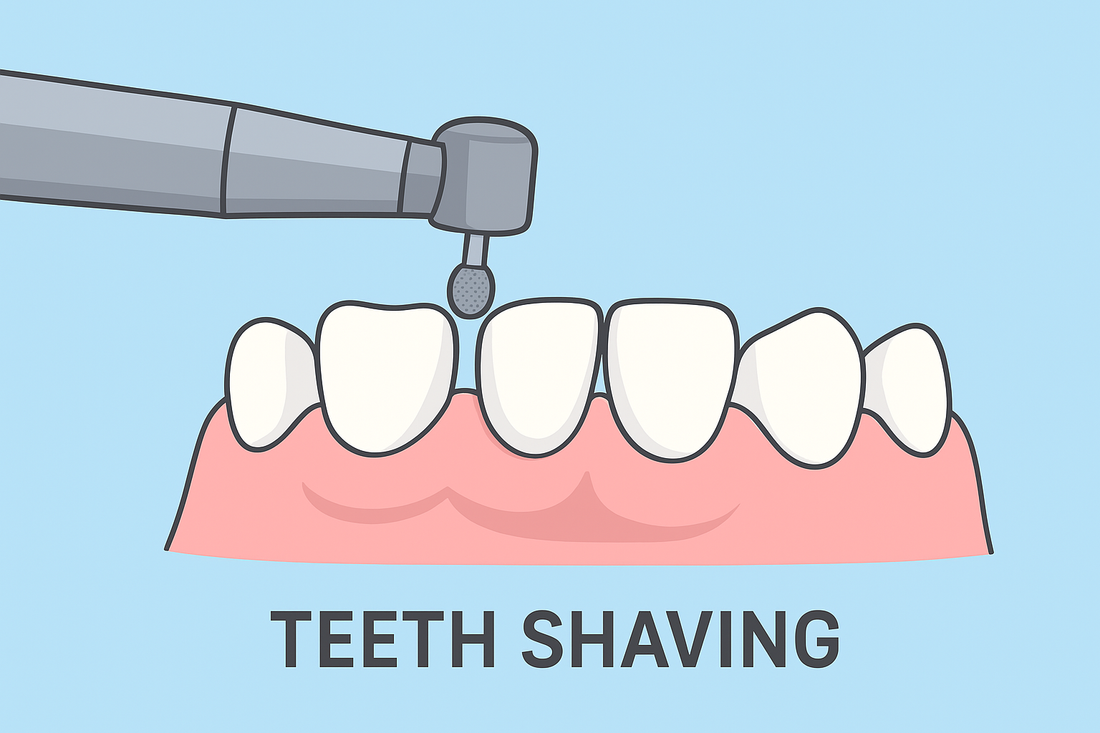
Table of Contents
- What Exactly Is Teeth Shaving?
- Why Teeth Shaving Is Done
- Do Veneers Require Teeth Shaving Every Time?
- Traditional Veneers: Standard Tooth Preparation
- Minimal Prep Veneers: The Gentle Middle Ground
- No Prep Veneers Option: When Shaving Isn’t Necessary
- Risks of Shaving Teeth
- Can You Avoid Tooth Shaving Altogether?
- Quick Comparison: Veneers vs. Other Treatments
- Tooth Shaving Before Veneers
- FAQs
If you want to have the type of smile you see in Hollywood movies, veneers are likely on your mind. Veneers are highly sought after for good reason: they can change your smile almost entirely by fixing chips, cracks, gaps, or even severe discoloration.
However, there is usually one step that can get people a little uneasy, and that is teeth shaving. You may have come across a video of a dentist shaving down perfectly healthy teeth, and it can look very intense. So, is tooth shaving always a step for veneers? Or are there other cases where your natural teeth can remain relatively intact?
What Exactly Is Teeth Shaving?
Before we talk about whether it’s necessary. Let’s first define exactly what teeth shaving is. Teeth shaving, or tooth preparation, is the removal of a very small amount of enamel from the surface of your teeth. By removing this trace amount of enamel, your dentist can achieve an even, flush fit of the veneer over its surface so that it doesn’t look bulky or out of place.
At this stage, many consumers become more than a little shocked by how much tooth is shaved for veneers. When placing traditional veneers, dentists typically remove 0.5 mm (the thickness of a fingernail). The point of this isn't to damage your teeth but rather to prepare the teeth for an even, natural fit.
However, that is an irreversible act. Once enamel is removed, it won't come back. And that is the reason you want to ask if you need this step done, in your case.
Why Teeth Shaving Is Done
If you simply place a veneer over an unprepared tooth, it can:
- Look bulky and unnatural.
- It sticks out slightly, affecting your bite.
- Be more prone to chipping because of poor placement.
By shaving a tiny layer, your dentist ensures:
- A seamless, natural-looking result.
- Better adhesion, so the veneer lasts longer.
- Comfort, you won’t feel like something is “sitting” on your teeth.
For many people, it’s the difference between a smile that looks like veneers and one that looks completely natural.
Do Veneers Require Teeth Shaving Every Time?
Here’s where things get interesting, no, not always. Whether you’ll need tooth shaving depends on several factors, like the type of veneers you’re getting, the condition of your natural teeth, and your cosmetic goals.
There are three main scenarios:
| Veneer Type | Amount of Tooth Shaved | Best For |
|---|---|---|
| Traditional Veneers | 0.5mm of enamel | Teeth with discoloration, chips, or uneven shapes. |
| Minimal Prep Veneers | 0.1–0.3 mm (very little) | Mild imperfections where some shaping is needed. |
| No Prep Veneers | None, no shaving required | Slight gaps or minor aesthetic changes. |
Let’s go a bit deeper into each option.
Traditional Veneers: Standard Tooth Preparation

With traditional veneers, shaving is usually essential. These veneers are slightly thicker, so the dentist must make space to avoid a bulky look. This is the most common type used when patients have:
- Severe discoloration.
- Misshapen or uneven teeth.
- Noticeable gaps or damage.
Consider this option a comprehensive smile makeover. It’s dramatic and long-lasting, but it does involve a permanent change to your natural teeth.
Minimal Prep Veneers: The Gentle Middle Ground

If you're not comfortable with aggressive tooth preparation, you may wish to consider the minimal prep veneers. They only require the removal of a very small amount of enamel, and sometimes, not enough to require anaesthesia.
These are appropriate for patients with minor imperfections, such as slightly rough edges or small spaces. With minimal prep veneers, you can save as much natural tooth structure, yet attain a nice cosmetic result.
No Prep Veneers Option: When Shaving Isn’t Necessary

As the name suggests, no prep veneers don’t require any shaving at all. Your dentist simply bonds the veneers directly to your natural teeth.
Sounds perfect, right? Well, not everyone is a candidate. No prep veneers usually work only if:
- Your teeth are small or slightly set back.
- There’s plenty of space for the veneers to sit without looking bulky.
- You’re correcting very subtle imperfections.
They’re incredibly conservative, but the results may not be as dramatic as traditional veneers.
Risks of Shaving Teeth
Even though tooth preparation is safe when done by an experienced dentist, it’s normal to feel a little cautious. Here are some potential risks to be aware of:
- Tooth Sensitivity: Removing enamel can make teeth temporarily sensitive to hot or cold foods. This usually settles within a few weeks.
- Irreversible Change: Once enamel is gone, it’s gone forever. If a veneer ever needs replacing, you’ll always need another restoration.
- Improper Shaving: If too much enamel is removed, it can weaken the tooth. That’s why choosing a skilled cosmetic dentist is crucial.
- Gum Irritation: Rare, but possible, especially if veneers don’t fit perfectly.
Can You Avoid Tooth Shaving Altogether?
If the idea of enamel removal makes you uneasy, you do have options.
- Ask About No Prep Veneers: If your teeth already have enough space or are slightly recessed, you might be a candidate.
- Consider Minimal Prep Veneers: This option uses ultra-thin porcelain, so only a tiny bit of enamel is removed.
- Alternative Treatments: Sometimes, orthodontics or professional whitening can achieve your desired look without veneers at all.
Quick Comparison: Veneers vs. Other Treatments
Sometimes, veneers aren’t the only solution. Here’s how they stack up against other options:
| Treatment | Best For | Limitations |
|---|---|---|
| Teeth Whitening | Stains and discoloration | Doesn’t fix chips or gaps |
| Orthodontics | Misaligned teeth | Longer treatment time |
| Composite Bonding | Minor chips or cracks | Less durable |
| Veneers | Multiple imperfections | May require shaving |
If you’re looking to address several concerns at once, like colour, shape, and alignment, veneers remain one of the most efficient choices.
Tooth Shaving Before Veneers
Let’s be honest: the thought of reducing tooth structure can sound daunting. But when done well, conservatively, it’s just one step toward achieving a natural-looking and balanced smile.
Not every patient will need excessive tooth preparation. Since some patients can even be candidates for no-prep veneers, they and leave their natural teeth entirely intact.
The focus is on unique, individual care. Your smile is different from anyone else’s, and so should your treatment. We will walk with you through every decision, every step of the way, until you have achieved your beautiful, confident smile without compromise.
But if you have been waiting for treatment because you are afraid of tooth reduction procedures, you can take a deep breath because there is a way forward that works for you.
FAQs
Not always. It depends on the type of veneers and your teeth’s condition; traditional veneers usually require some shaving, while minimal prep or no prep veneers need little to no.
Yes, if you’re a good candidate for no prep veneers, which are bonded directly to your natural teeth without removing enamel.
No prep veneers don’t require shaving, and minimal prep veneers need only a tiny amount of enamel removal.
Citations:
What is Teeth Shaving? (n.d.). Colgate. https://www.colgate.com/en-us/oral-health/mouth-and-teeth-anatomy/what-is-teeth-shaving
Larson, J. (2020a, July 27). What’s the purpose of shaving down teeth? Healthline. https://www.healthline.com/health/dental-and-oral-health/teeth-shaving
Clinic, C. (2024, May 6). The dangerous trend of DIY teeth shaving. Cleveland Clinic. https://health.clevelandclinic.org/teeth-shaving







 Australia
Australia New Zealand
New Zealand Malaysia
Malaysia English
English Portuguese
Portuguese English
English English
English English
English English
English English
English Canada
Canada